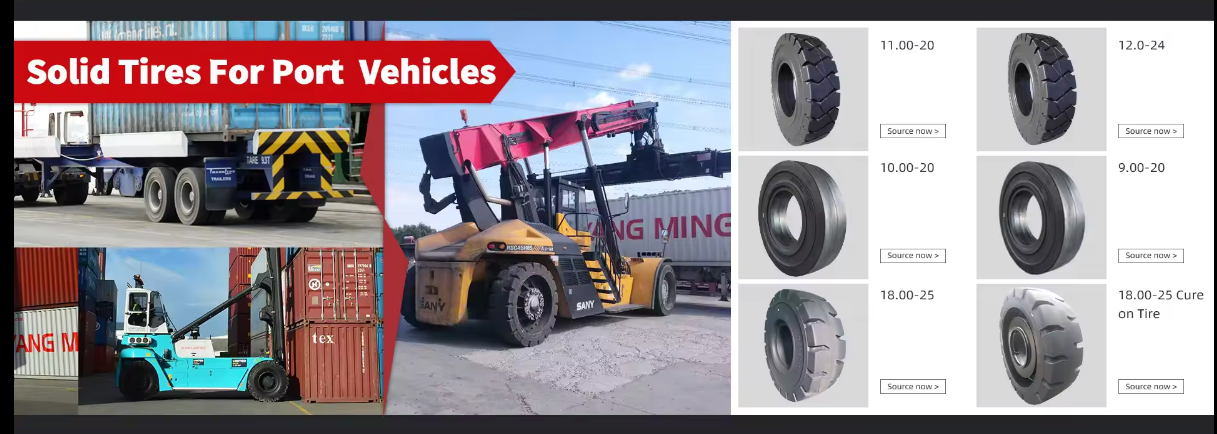In the world of port logistics and container handling, Reach Stacker Tires play a crucial role in ensuring stability, durability, and performance. These specialized industrial tires support the massive loads and demanding conditions of reach stackers, which are key machines in container terminals, freight yards, and logistics centers. For B2B buyers, understanding tire specifications and performance factors is essential for optimizing operational safety and efficiency.
The Role of Reach Stacker Tires in Material Handling
Reach stackers are designed to lift and transport heavy containers over short distances with precision. Their tires bear enormous weight and endure frequent turns, starts, and stops on rough or uneven surfaces. Choosing the right reach stacker tire ensures:
-
Better traction and stability on concrete and asphalt surfaces
-
Reduced rolling resistance for improved fuel efficiency
-
Enhanced shock absorption to protect vehicle components
-
Longer service life, reducing maintenance downtime
These features are vital for maximizing productivity and minimizing operational risks in busy port environments.
Key Types of Reach Stacker Tires
Selecting the appropriate tire type depends on the operational environment and load requirements. The main categories include:
-
Pneumatic Tires:
-
Provide excellent cushioning and traction
-
Suitable for outdoor use and uneven surfaces
-
Require regular air pressure checks
-
-
Solid Tires:
-
Maintenance-free and puncture-resistant
-
Ideal for heavy loads and harsh environments
-
Longer lifespan but less cushioning than pneumatic types
-
-
Radial Tires:
-
Offer better heat dissipation and smoother operation
-
Preferred for high-speed and long-distance movement
-
-
Bias Tires:
-
Durable and cost-effective
-
Commonly used in low-speed, high-load operations
-
Each type has its own advantages depending on application needs, terrain, and operating conditions.
Performance Factors to Consider When Choosing Reach Stacker Tires
When selecting a reach stacker tire, consider the following performance parameters:
-
Load Capacity: Must withstand the machine’s maximum lifting weight.
-
Tread Design: Deep treads improve grip, while smoother treads reduce wear on hard surfaces.
-
Heat Resistance: Essential for continuous operation under heavy load.
-
Durability: Reinforced sidewalls and compounds resist cuts and abrasions.
-
Traction Control: Provides stability during acceleration, braking, and cornering.
Premium tire brands often incorporate advanced rubber compounds and structural technology to enhance performance under extreme conditions.
Industrial Applications of Reach Stacker Tires
Reach stacker tires are widely used in heavy-duty logistics and industrial applications, including:
-
Port Terminals: For container stacking and movement.
-
Freight Yards: Handling intermodal containers and cargo.
-
Industrial Warehouses: Transporting large materials or equipment.
-
Steel Mills & Construction Sites: Supporting material transfer in tough terrain.
By choosing high-performance tires, companies ensure smoother operations, reduced energy consumption, and increased equipment lifespan.
Conclusion
The Reach Stacker Tire is an essential component for maintaining operational stability and safety in heavy-duty environments. Its design, material quality, and load-bearing capacity directly affect machine performance and total operating costs. For B2B buyers, investing in reliable, high-quality tires means not only improving productivity but also reducing downtime and long-term maintenance expenses.
FAQ: Reach Stacker Tire
1. What makes a tire suitable for reach stackers?
A reach stacker tire must support heavy loads, resist heat buildup, and provide stability on hard industrial surfaces.
2. Are solid tires better than pneumatic tires for reach stackers?
Solid tires are more durable and puncture-resistant, making them ideal for harsh environments. Pneumatic tires, however, offer better ride comfort and traction.
3. How often should reach stacker tires be replaced?
Replacement depends on usage intensity, terrain, and maintenance. Regular inspection for wear and damage is recommended every 3–6 months.
4. What factors affect the lifespan of reach stacker tires?
Load weight, operating surface, temperature, and maintenance practices all influence tire longevity
Post time: 15-10-2025

